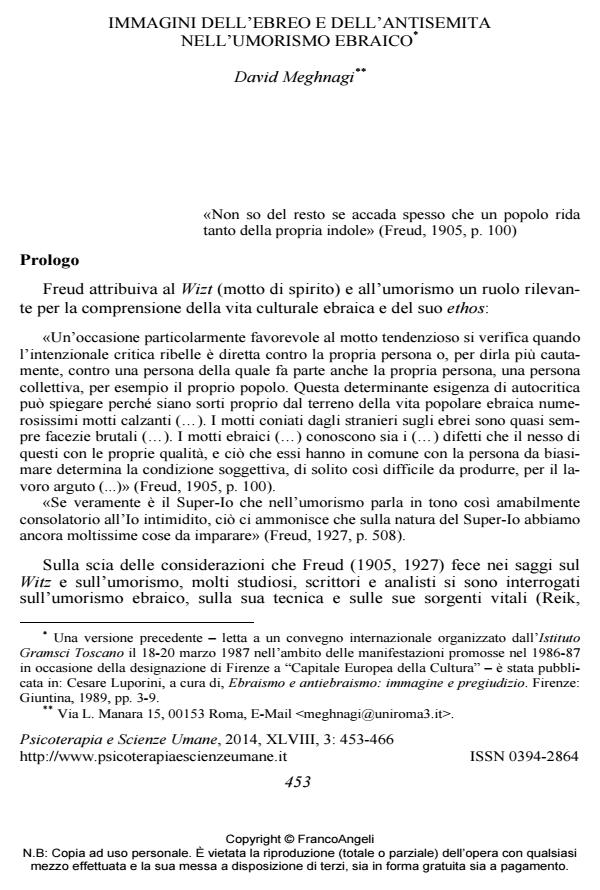Portrayals of the Jewish and of the anti-Semite in Jewish humor
Journal title PSICOTERAPIA E SCIENZE UMANE
Author/s David Meghnagi
Publishing Year 2014 Issue 2014/3 Language Italian
Pages 14 P. 453-466 File size 68 KB
DOI 10.3280/PU2014-003005
DOI is like a bar code for intellectual property: to have more infomation
click here
Below, you can see the article first page
If you want to buy this article in PDF format, you can do it, following the instructions to buy download credits

FrancoAngeli is member of Publishers International Linking Association, Inc (PILA), a not-for-profit association which run the CrossRef service enabling links to and from online scholarly content.
Freud attributed to "Witz" and humor an important role for understanding Jewish cultural life and ethos. Many scholars and psychoanalysts studied Jewish humor, its technique and vibrant sources. Within clinical practice, the meaning of humorous communication was studied in its many defensive and creative aspects aimed at banishing anxiety and creating new meanings. The analogy with artistic and literary creation has encouraged some authors to discuss the presence of a "tertiary" process, distinct from primary and secondary processes. Through the analysis of some Jewish jokes, humor’s strategies are seen as a way of dealing with the challenges posed to Jewish life. Jewish humor’s strategy is complex and articulated: it does not "censor" accusations, it appears to "embrace" the accusation, making it less powerful with new meanings that make the accusation ridiculous and increase the range of knowledge, with cathartic and liberating effects. The analysis of jokes becomes a journey through Jewish history and culture.
Keywords: Jewish humor, Witz, anti-Semitism, Judaism, psychoanalysis
- ‘Aleichem Sch. (1894-1916). Tewje, der Milchmann (trad. it.: La storia di Tewje il lattivendolo. Roma: Formiggini, 1928; Milano: Feltrinelli, 1982).
- Arieti S. (1976). Creativity: The Magic Synthesis. New York: Basic Books (trad. it.: Creatività. La sintesi magica. Roma: Il Pensiero Scientifico, 1979).
- Canetti E. (1960). Masse und Macht. Hamburg: Claassen Verlag (trad. it.: Massa e potere. Milano: Rizzoli, 1972; Milano: Adelphi, 1981; Milano: Bompiani, 1981).
- Corrao F. (1982). Logos e Komos. In: Fornari F., a cura di, La comunicazione spiritosa (Il motto di spirito da Freud a oggi). Firenze: Sansoni, 1982, pp. 269-294.
- Devarim / Parole /Cose / Deuteronomio (VI-V secolo a.C.). Roma: Edizioni Paoline, 1967.
- Freud S. (1905). Il motto di spirito e la sua relazione con l’inconscio. Opere, 5: 3-211. Torino: Boringhieri, 1972.
- Freud S. (1927). L’umorismo. Opere, 10: 503-508. Torino: Boringhieri, 1978.
- Freud S. & Zweig A. (1927-39). Lettere sullo sfondo di una tragedia, 1927-1939. A cura di David Meghnagi. Venezia: Marsilio, 2000.
- Howe I. (1976). World of our fathers. San Diego, CA: Harcourt Brace Jovanovich (trad. it.: Terra promessa. Ebrei a New York. Milano: Edizioni di Comunità, 1985).
- Jonas H. (1984). Der Gottesbegriff nach Auschwitz. Eine jüdische Stimme. In: Reflexionen finsterer Zeit. Zwei Vorträge von Fritz Stern und Hans Jonas. Tübingen: J.C.B. Mohr, 1984 (trad. it.: Il concetto di Dio dopo Auschwitz. Una voce ebraica. Il Mulino, 1986, 3: 438-452. Genova: Il Melangolo, 1989).
- Jones E. (1953-57). The Life and Work of Sigmund Freud (3 volumes). New York: Basic Books, 1953 (vol. I), 1955 (vol. II), 1957 (vol. III) (trad. it.: Vita e opere di Freud. Milano: Il Saggiatore, 1962, tre volumi).
- Meghnagi D. (1982). La Kabbalah come metafora dell’esilio. Rassegna Mensile di Israel, XLVIII, 7-12 (luglio-dicembre [Tamuz 5742-Kislev 5743]) (terza serie): 109-115.
- Meghnagi D. (1985). Modelli freudiani della critica e teoria psicoanalitica. Roma: Bulzoni.
- Meghnagi D. (1986). Riso ebraico. Micromega, 4: 64-71.
- Meghnagi D. (1991). Jewish humor on psychoanalysis. International Review of Psychoanalysis, 18: 223-228.
- Meghnagi D. (1992). Il Padre e la Legge. Freud e l’Ebraismo. Venezia: Marsilio (terza edizione aggiornata: 2004).
- Meghnagi D. (2000). Introduzione. In: Freud & Zweig, 1927-39, pp. 9-44.
- Meghnagi D. (2010). Le sfide d’Israele. Lo Stato ponte tra Occidente e Oriente. Venezia: Marsilio.
- Meghnagi D. (2011). From the dreams of a generation to the theory of dreams. Freud’s Roman dreams. International Journal of Psychoanalysis, 92, 3: 675-694. DOI: 10.1111/j.1745-8315.2011.00463.x
- Polanyi K., with the collaboration of Arensberg C. & Pearson H., editors (1957). Trade and Market in the Early Empires: Economies in History and Theory. Glencoe, IL: Free Press
- (trad. it.: Traffici e mercati negli antichi imperi. Le economie nella storia e nella teoria. Torino: Einaudi, 1978).
- Poliakov L. (1969). De l’antisionisme a l’antisémitisme. Paris: Editions Calmann-Levy (trad. it.: Dall’antisionismo all’antisemitismo. Firenze: La Nuova Italia, 1971).
- Reik Th. (1929). Zur Psychoanalyse des Jüdischen Witzes. Imago, 15: 63-88.
- Reik Th. (1954). Freud and Jewish wit. Psychoanalysis, 5: 13-28.
- Reik Th. (1962). Jewish Wit. New York: Gamut Press.
- Rodinson M. (1966). Islam et capitalisme. Paris: Seuil (trad. it.: Islam e capitalismo. Saggio sui rapporti tra economia e religione. Torino: Einaudi, 1968).
- Sacerdoti G. (1987). L’ironia attraverso la psicoanalisi. Milano: Raffaello Cortina.
David Meghnagi, Immagini dell’ebreo e dell’antisemita nell’umorismo ebraico in "PSICOTERAPIA E SCIENZE UMANE" 3/2014, pp 453-466, DOI: 10.3280/PU2014-003005